When was the last time you just let yourself be a child again? Bringing a sense of ease and playfulness into your life is the purpose of Danilo’s very own concept “Playfight – Flowcatcher”, connecting you with your inner child and warrior.
Danilo has always been enthusiastic about physical movement, practicing yoga, dance and different types of martial arts. Today, he leads workshops to make you feel more free, grounded and light.
I sat down with Danilo by the Rhine River in my old hometown Bonn to talk to him about what he aims at with “Playfight – Flowcatcher”. It was very informative, and also a lot of fun!
Dear Danilo, in our exchange so far I could already tell: Playfight is your absolute passion. Why don’t you explain what’s behind this term?
Playfight is a word that’s coming out in a big way right now. You can define it as playing and brawling. It started in earlier times, as something mystical, a game with the spirits, a meditative activity. In the Middle Ages, the fun factor was added – for example, parents playfully scuffled with their children.
So has the fun factor always been there?
That’s difficult to say, you can only work with estimates. Nowadays, with games and scuffles, people are looking for a connection with others.
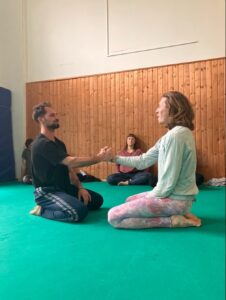
So not only among children?
Exactly. We know how it often is: I don’t know strangers, I don’t need to get close to them. But if you approach it playfully, it’s actually quite easy to reconnect and not be such strangers to each other. You often forget that, but we’re all the same when we play.
Playfighting also requires a lot of physical effort. Many people are no longer used to that.
Of course it’s physically demanding, but the good news is that it’s a game – a fun fight. While you’re playing, you don’t really notice how strenuous it is. Afterwards, you come out happily exhausted. If you then extend that – as I do – you integrate other parts of the body, strengthen them, relieve them. And that in connection with play… there can be so much for mind and body. Perhaps one has regained a piece of childhood.
I still remember myself how much I liked to simply scuffle as a child. Is that simply the basis of your workshops? You encourage your participants to be children again?

Yes, the thing is that I have often heard “I’m too old, I can’t play anymore”. Then I always have to answer “You didn’t stop playing because you’re old. You got old because you stopped playing.”
What is particularly nice is that in this context a protected space has been created where one can simply play quite freely. No one can see me making an ass of myself, so to speak, or playing like a child. You often feel ashamed, but when you have the opportunity to do that in a protected space, you often wonder why you ever stopped.
Do you also know cases where an aggressive energy came out rather than a playful one?
I’ve experienced both, but not really aggressive. You make it very clear at the beginning that you’re playing, that it’s not serious. You realize that relatively quickly, and respect also develops very quickly. You don’t want to show who’s better – which is not the point at all – but it’s just about playing and letting go. You can also agree on the intensity of the scuffle beforehand, for example, if you want to test boundaries.
One game I like to incorporate: I put on a sock, you put on a sock, and we try to take each other’s socks. And then pretty quickly you’re in a little playful wrestling match. You grab each other’s shoulders, push each other to the ground, but we start at the knees, there’s not much that can happen. That alone creates so much fun!
You just said it’s not about being better than the other one. But is there still a winner, or how does such a fight end?
In the game with the sock, for example, you can say that it starts over when a sock is taken off. You can also try to get out of a position, for example, if someone is sitting on top of you, or you can try to push your partner to the ground for three seconds.

If I am in a situation where I feel uncomfortable, how could I stop?
My workshops are not just called Playfight, but Playfight – Flowcatcher. That means I show a lot of different flowing movements and different types of playfight. When we fight playfully, I also like to show movements from self-defense. For the warm-up, I also show how to free yourself. Of course, you can always say “Stop” and take a break at any time you like.
What other influences affect your concept? You’ve already mentioned martial arts – what else are there?
A lot from dance sports, I like to dance very much myself, and have incorporated many movements. Flowing movements with the whole body are a great warm-up, Ecstatic Dance, Capoeira, Contact Dance can be mentioned here. This can be designed and varied in a very free and playful way. For example, with a blindfold you get even more into the feeling.
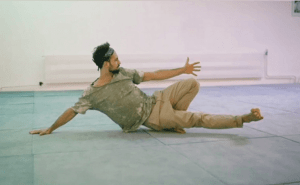
Do people come to your workshops with friends or alone?
Most come alone; those who come in pairs are usually couples. Mostly people want to reconnect with others, because that has become really difficult nowadays.
Right now is actually an ideal time for that, because many have had a lack of physical contact due to the pandemic.
Absolutely. There are always those who have completely withdrawn due to Corona, but those are only a few. Most of them are looking for that connection right now and throwing themselves into it, and that’s really nice to see. I am very happy that I can experience this time now after this low – like a Phoenix from the ashes.
It gives me a lot to hold this space, to pass on my knowledge and experience and to see what happens when you let go a little bit.
Again, back to the dance and martial influences – you mentioned earlier that you incorporate them into your warmup. Do you also encourage participants to weave them into their fighting?

I also like to weave in animal moves, for example monkey walks, where you walk on all fours. You’re not used to that kind of movement anymore, especially if you’re doing a sedentary job. It’s incredibly good for you, because your spine is often under tension. Moving around in all kinds of ways strengthens and relieves the back. In between, I also always invite you to linger in the Yogi Squat, or just let yourself hang out if you find a pole in a playground.
Can I take part in such a workshop even if I am absolutely unathletic?
Of course! You don’t need to be athletic at all, it’s all about the playing and brawling, and everyone can do that.The beauty is that you don’t have to prove anything to anyone. There are always movements that are easier, but the main thing is to have fun and connect – also with yourself. That you rediscover or remember things, movements that used to bring you joy. As soon as you behave like a child again, you become more open – to other things and people. You repress a lot and no longer dare to act out this playfulness. I always see the heart open in the eyes of the participants.
Keyword “finding a connection with yourself” – that’s a parallel to yoga and meditation.
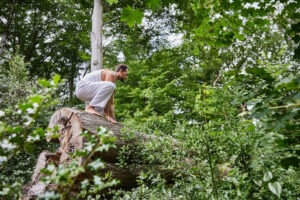
As soon as you focus on one thing and block out everything else, which happens every time at these workshops, you are automatically in a kind of meditation.
Then maybe that’s even more accessible to those who say they can’t sit still?
Right. Of course, traditional meditation also has great qualities and I like to use it at the end of workshops.
It’s probably easier then after letting off steam.
Exactly, especially for people who never really move their body otherwise.
As for the yoga, after the warm-up, we mobilize and do a dynamic stretching session. Of course, yoga is also part of that.
Describe how a workshop like this works for you.
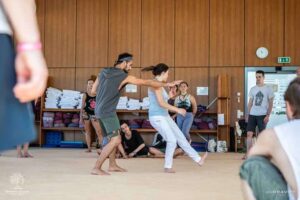
First, we all get together in a circle and introduce ourselves so that we get to know each other a bit. Everyone shares a word, a sentence or an intention as to who they are and why they’re here. Sometimes I also include a trust game at the beginning, which can always look different. Then we continue with a warm-up to prepare the body. Here, too, I always vary. Then we mobilize and stretch to get in the right mood for the following movements. And then comes the playful part with animal moves – we imitate a few animals (laughs). This warms us up further and strengthens the whole body, without us even noticing. Then there’s a smooth transition to a contact dance.
Do you let people choose their own partners?
First of all yes, then I announce a change, so that people who brought someone with them also get in contact with someone else. With a new person you have to adjust all over again. This new adjustment challenges our “inner warrior” by testing boundaries – something we hardly dare to do otherwise. The inner warrior also stands for determination, assertiveness, qualities that we can always put to good use.
So the participants are in contact dance. After that, there is then fighting?
After that, I show a few more flowing movements, such as from capoeira. So then it comes to using dance moves to dodge attack maneuvers like kicks. Animal moves also come into play here, mixed with the martial – you become a Kung Fu Panda, so to speak. (At this point we had to take a break due to laughter).
You just realize, “I now have a large repertoire of movements and can move out of situations in many ways” – whether that’s kicking movements, monkey walk, or dog looking down.
And then from there it flows into playing and roughhousing. And since there are so many flowing movements involved, I call it flowcatching.
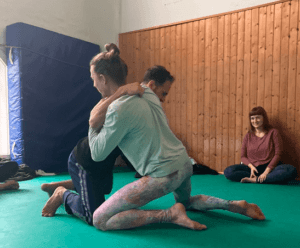
Do everyone fight in pairs at the same time, or do only two fight at first and the others watch?
There are both. Someone can be in the middle and choose another participant as a partner. The others watch the playfight, then the one who was chosen picks someone new. But everyone can also choose someone and it is fought in parallel in the room.
It is also very important to me that the participants can always withdraw if they don’t feel comfortable with something, without justification. Of course, before the fight I also explain that the partner should be treated with respect, that you don’t want to hurt anything. In consultation with the partner, the tussle can be as gentle or as dynamic as you like. All in all, such a workshop lasts between two and three hours.
What does the conclusion look like?
First of all, we lie down on our backs, similar to Savasana, to calm down, relax and let everything take effect. Especially in the summer, when the workshops take place in the forest, this is very nice. Indoors you don’t always have mats, but often I take some with me. Sometimes I also recommend knee and elbow pads to the participants.
We also often do a circle where we share how we’re feeling. And then the class ends differently, maybe with an Om, maybe with a breathing exercise, a group hug – I do that spontaneously.

Speaking of hugs, you read over and over again how good hugs do you. So we’re bound to take something positive away from the physical contact at Playfight, right?
Absolutely, if only because we let ourselves get involved with another person and thus open up. For many, that’s an overcoming. The playful side also brings out not only the Inner Warrior, but also the Inner Child. In the times we live in, our childlike side is often no longer active at all, and many long to reawaken it – even to communicate just that, and to re-establish that connection with others.
And that’s your drive, too?
Definitely. Both verbally and physically, in a playful way. It’s just so inside me, I’ve always felt that, and then at some point I was able to give the first workshop and flourish doing it – not only doing it myself, but also passing it on. People are getting more and more infected now.
How do your participants leave such workshops?
It’s really magic, what happens there. One is happily exhausted and has noticed that one has become more open. For some it has a bit of an after-effect, others know immediately “that’s what I’ve always been looking for”. Many gain more courage from it and then want to pass it on – either in everyday life or in such a way that it fits their own activity. You also experience your body in completely different movements. On a physical as well as on a mental level, a lot of things come loose.
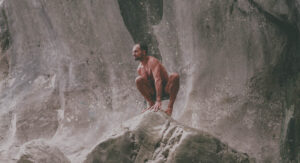
If I want to continue after a workshop, how would you go about finding someone privately to do it?
If I want to continue, I actually just have to take the initiative by getting myself to do movements from my childhood again, without fear of looking ridiculous. Playfight can be done anytime and anywhere, with friends, family members….
Sometimes, of course, you meet people who don’t really want to open up anymore. You can’t force anything, all you can do is share what you’ve experienced that’s beautiful, and maybe that sets an impulse. For me personally it was like that, that I heard about a workshop, took part and realized “this is it, finally!”.
We’ve talked a lot now about the benefits. Who can particularly benefit from it, who would you particularly recommend your workshops to?
Both young people and adults. Very many young people don’t do any sport at all, and I think the body simply has to be used. Often they simply haven’t discovered what they like to do yet. Especially these young people should be shown as wide a range as possible of what you can do with your body. Through all the movements that flow into my workshops, you can easily find out what you like and what you don’t like. And the prevention of physical ailments at a young age should not be underestimated.

Do you differentiate between age groups in your workshops?
No, not at all, only the benefits are different, everyone takes away something different for themselves.
That’s nice when generations meet, isn’t it?
In any case, it’s a very interesting experience to do this playful exercise with someone who belongs to a different age group. In this atmosphere, age is quickly forgotten.
What would you like to pass on to people who have now developed an interest in the subject as a result of this interview?
Through word of mouth and social media groups, you can find information and dates for workshops. I think everyone should have tried that to see what happens to you. What can I discover or rediscover? What can my body do? In general, it’s a great way to connect with others and foster openness. In this day and age, we especially need that!
What do you say to those who would like to, but don’t dare?
My message would be: since we have a body, it should be respected, savored and used to the fullest. It would be much too bad not to discover it.
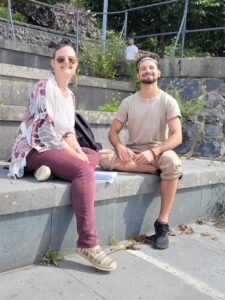
Beautiful conclusion, thank you so much for this interview!
Connect with Danilo and stay up to date about his workshops via Instagram or Facebook!




